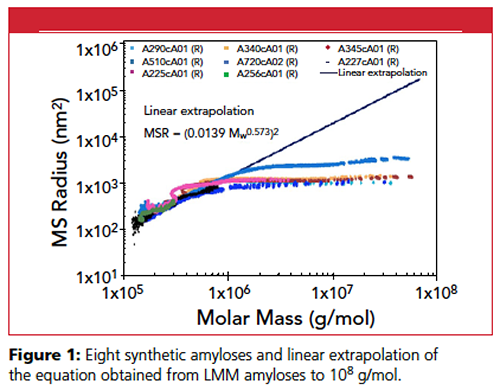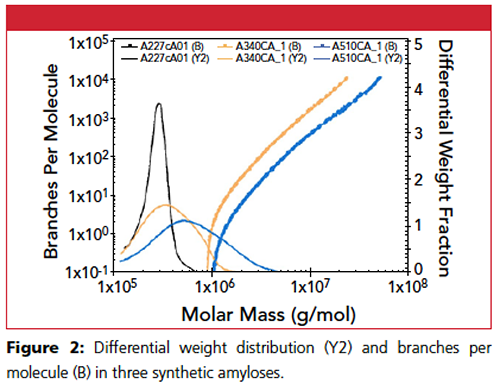SEC-MALS Analysis of Linear and Branched Synthetic Amyloses
Amylose is an occasionally branched biopolymer and, together with amylopectin, the hyper-branched component, a constituent of starch. Determination of branching in amylopectin, an important property affecting viscosity, stiffness, and thermo-mechanical performance, requires a fully linear amylose analogue. This application note describes how synthetic amyloses from enzymatic (phosphorolytic) reaction were checked for their linearity using size-exclusion chromatography-multi-angle light scattering (SEC-MALS).
Amylose is an occasionally branched biopolymer and, together with amylopectin, the hyper-branched component, a constituent of starch. Determination of branching in amylopectin, an important property affecting viscosity, stiffness, and thermo-mechanical performance, requires a fully linear amylose analogue. This application note describes how synthetic amyloses from enzymatic (phosphorolytic) reaction were checked for their linearity using size-exclusion chromatography-multi-angle light scattering (SEC-MALS).
Materials and Methods
Separations were performed on Shodex OHpak HQ-806, -805, -804, and -803 SEC columns. A DAWN® MALS detector and Optilab® differential refractometer were placed downstream of the columns to analyze molar mass and size of each eluting fraction. Data were acquired and analyzed by ASTRA® chromatography software to calculate differential weight distributions, conformation plots of mean-square radius versus molar mass, and branching per molecule.
The molar mass M and root-mean-square radius Rg were calculated at each slice using dn/dc = 0.146 mL/g. At least three data sets per sample were averaged together.
Results and Discussion
Branching calculations (branching ratio gM, branches per molecule B, and long-term branching λ) were performed using the ZimmâStockmayer equations (trifunctional random branching). The molar mass distributions of low molar mass (LMM) synthetic amyloses are narrow in the range of 1–4 × 105 g/mol, and the branching calculations show that these polymers are strictly linear. The differential weight distribution plots of high molar mass (HMM) amyloses show a broader distribution extending into the 106 g/mol range. A distinct halt to the rise of Rg with increasing M is noticeable beginning around 1 million g/mol (Figure 1). Rigorous analysis shows that branching starts (B = e0) at approximately 8 × 105 g/mol (Figure 2).


Conclusions
A fully-linear amylose was synthesized for use in branching analysis of naturally hyperbranched amylopectin. The synthetic amylose samples analyzed here were linear in the LMM range up to ~ 800,000 g/mol, but exhibited branching at higher molar masses. Even though the linear samples ended at 800,000 g/mol, the conformation plot of linear amylose can be safely extrapolated up to 108 g/mol, enabling analysis of quite large amylopectins. Hence the SEC-MALS method using a DAWN and Optilab has proved to be useful to check branching in HMM biopolymers on the basis of linear
Wyatt Technology Corp.

6330 Hollister Ave, Santa Barbara, California 93117, USA
Tel.: 1 (805) 681 9009
Website: www.wyatt.com
